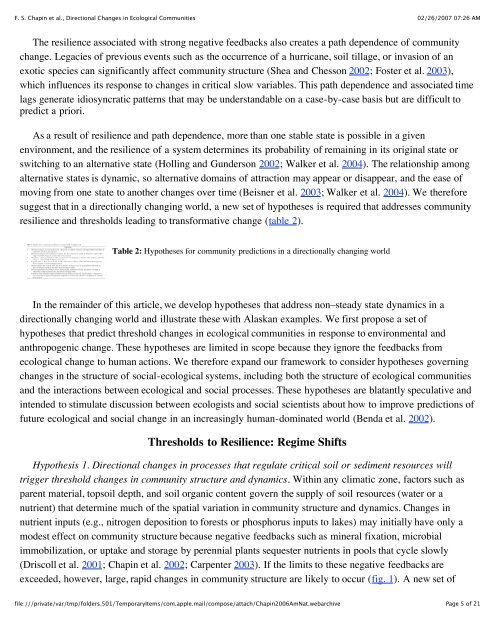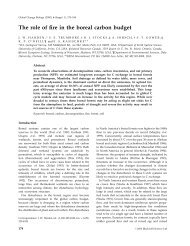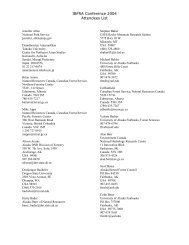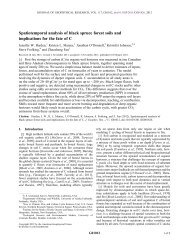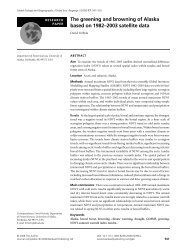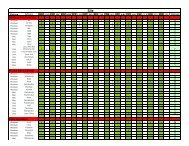Chapin, F.S., III, M.D. Robards, H.P. Huntington, J.F. Johnstone, S.F. ...
Chapin, F.S., III, M.D. Robards, H.P. Huntington, J.F. Johnstone, S.F. ...
Chapin, F.S., III, M.D. Robards, H.P. Huntington, J.F. Johnstone, S.F. ...
Create successful ePaper yourself
Turn your PDF publications into a flip-book with our unique Google optimized e-Paper software.
F. S. <strong>Chapin</strong> et al., Directional Changes in Ecological Communities<br />
02/26/2007 07:26 AM<br />
The resilience associated with strong negative feedbacks also creates a path dependence of community<br />
change. Legacies of previous events such as the occurrence of a hurricane, soil tillage, or invasion of an<br />
exotic species can significantly affect community structure (Shea and Chesson 2002; Foster et al. 2003),<br />
which influences its response to changes in critical slow variables. This path dependence and associated time<br />
lags generate idiosyncratic patterns that may be understandable on a case-by-case basis but are difficult to<br />
predict a priori.<br />
As a result of resilience and path dependence, more than one stable state is possible in a given<br />
environment, and the resilience of a system determines its probability of remaining in its original state or<br />
switching to an alternative state (Holling and Gunderson 2002; Walker et al. 2004). The relationship among<br />
alternative states is dynamic, so alternative domains of attraction may appear or disappear, and the ease of<br />
moving from one state to another changes over time (Beisner et al. 2003; Walker et al. 2004). We therefore<br />
suggest that in a directionally changing world, a new set of hypotheses is required that addresses community<br />
resilience and thresholds leading to transformative change (table 2).<br />
Table 2: Hypotheses for community predictions in a directionally changing world<br />
In the remainder of this article, we develop hypotheses that address non–steady state dynamics in a<br />
directionally changing world and illustrate these with Alaskan examples. We first propose a set of<br />
hypotheses that predict threshold changes in ecological communities in response to environmental and<br />
anthropogenic change. These hypotheses are limited in scope because they ignore the feedbacks from<br />
ecological change to human actions. We therefore expand our framework to consider hypotheses governing<br />
changes in the structure of social-ecological systems, including both the structure of ecological communities<br />
and the interactions between ecological and social processes. These hypotheses are blatantly speculative and<br />
intended to stimulate discussion between ecologists and social scientists about how to improve predictions of<br />
future ecological and social change in an increasingly human-dominated world (Benda et al. 2002).<br />
Thresholds to Resilience: Regime Shifts<br />
Hypothesis 1. Directional changes in processes that regulate critical soil or sediment resources will<br />
trigger threshold changes in community structure and dynamics. Within any climatic zone, factors such as<br />
parent material, topsoil depth, and soil organic content govern the supply of soil resources (water or a<br />
nutrient) that determine much of the spatial variation in community structure and dynamics. Changes in<br />
nutrient inputs (e.g., nitrogen deposition to forests or phosphorus inputs to lakes) may initially have only a<br />
modest effect on community structure because negative feedbacks such as mineral fixation, microbial<br />
immobilization, or uptake and storage by perennial plants sequester nutrients in pools that cycle slowly<br />
(Driscoll et al. 2001; <strong>Chapin</strong> et al. 2002; Carpenter 2003). If the limits to these negative feedbacks are<br />
exceeded, however, large, rapid changes in community structure are likely to occur (fig. 1). A new set of<br />
file:///private/var/tmp/folders.501/TemporaryItems/com.apple.mail/compose/attach/<strong>Chapin</strong>2006AmNat.webarchive<br />
Page 5 of 21


